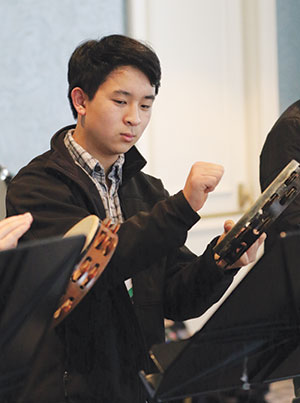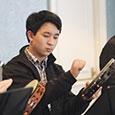Percussion is the largest family of instruments, requiring students to master a wide diversity of playing techniques. In large ensemble settings, the repertoire for a single concert typically incorporates quite a few of these instruments, with each player perhaps covering several at a time. Some composers and arrangers indicate clearly which instruments should be grouped together for each player; others do not, requiring directors and players to determine what works best. In either case, assigning parts to percussion students is a crucial factor in their overall development as musicians and the key for students to enjoy a full, broad experience on as many instruments as possible over the course of their musical education. To that end, when assigning parts directors should consider individual strengths and weaknesses, interactions among the parts, players’ overall time on task, and logistics.

Students’ Strengths and Weaknesses
Seek opportunities within the repertoire for your players to capitalize on their musical and technical strengths and also improve their weaknesses. This foresight requires careful attention to their playing in rehearsals and concerts and perhaps simple auditions, especially for incoming players.
The challenge with this approach is fitting everyone into appropriate roles overall. To help you see the big picture, create a simple table, with repertoire pieces across the top, players down the side, and particular instrument assignments in each cell. This will help you see how balanced each player’s instrumentation will be and how engaged they will be overall on a particular concert. For example, you will quickly notice if one student is assigned to snare drum way too often, or another has no pitched percussion parts at all. This chart will also be useful in the long term; save them to track how instruments have been assigned from concert to concert, year to year.
When considering students’ strengths and weaknesses, look for indicators in the repertoire that a given part may require immediate solid playing or allow for gradual growth, respectively. For example, an extended xylophone feature or a busy timpani part with fast and frequent pitch changes might be assigned to your best mallet player and your strongest timpanist. Your ensemble could suffer substantially on these pieces in the absence of solid playing relatively early in the rehearsal cycle.
On the other hand, a few bit parts on the xylophone or a sparse timpani part with static pitches might be the perfect opportunity to initiate the opposite assignments for those two players. The point is to start all students logically and gradually on instruments with which they are less familiar; as they grow as musicians, they become the flexible players that can allow for the next generation to begin. Ultimately, all of your players then finish their studies with a broad range of percussion skills.
Interactions Among Parts
In addition to assessing and addressing individuals’ particular strengths, directors should take into account the ways that given parts within a piece interact. For example, complicated passages of on- and off-beats between two players on bass drum and crash cymbals require not only that two players be confident in their own parts, but that they be able to play together seamlessly. Extended unison passages on marimba, xylophone, and bells require not only that three of your players have strong mallet skills but that they can match each other’s dynamics, articulations, and phrasing exactly.
Assigning parts according to the musical interactions they contain is akin to fielding a sports team; the relative roles of the players is what helps make the whole greater than the sum of its parts. Ultimately, we would love for all of our percussionists to be able to play any part in any situation. The question to consider as players develop is “When is the most appropriate time to introduce each new challenge?” Again, keen perception of students’ natural and conditioned skill sets will help directors organize their players’ roles effectively.
Overall Time on Task
Many percussion parts in large ensembles are rather sparse when compared to those of other instrument families. Cymbal crashes, chime notes, and bass drum rolls, for example, occur relatively infrequently within most pieces, requiring students to be patient, count carefully, and enter with confidence. When a student is assigned to a number of parts containing only a handful of notes, engagement problems, substandard music learning experiences, and even classroom management issues can ensue.
Remember that percussionists can learn valuable lessons from both busy, constant parts (a snare drum ostinato or glockenspiel melody) and sparse, isolated ones (a tam-tam blast or delicate triangle tap). From the former, they may learn how to groove with others in their section and the rest of the ensemble; from the latter, they may develop independence and self-confidence to make their solo entrances strong and clear under pressure. Offer your students many opportunities to do both, and in doing so, you will help balance their overall time on task as well.
Logistics
In addition to fostering breadth and depth of students’ musical growth and engagement, directors must remain keenly aware of logistics. Consider how much time students have to move between instruments or stations, whether they need to change mallets, if they can see you during and after their shift, whether other students are shifting at the same time, and how they can leave clear paths among all instruments. These concerns in combination can help you set all students up for success on their assigned parts.
Sometimes, two or more of these questions taken together can provide surprising answers and lead to creative solutions. It may seem logical, for example, to have a student cover vibraphone and chimes at a single station because both are mallet instruments. However, switching back and forth between those two types of mallets is cumbersome. Perhaps the vibraphone player could instead cover a suspended cymbal part using the same mallets, while another player stays at the chimes. If that suspended cymbal is too far away because, for example, the snare drummer has to play it also, add a second cymbal to the overall setup. Making sure students have all the right instruments and mallets in the most efficient, effective locations often requires placing doubles or triples of them strategically throughout the section. Similarly, putting players in the right spots by assigning them parts wisely can save a lot of trouble in both practice and performance.
Turning Over Assignment Responsibility to Students
This may be the most important part of the whole process; students should understand for themselves all of the above considerations. The best way to accomplish this is to gradually and consistently turn over the responsibility of part assignments to them. You may want to develop a system in which more experienced students assign parts while also training less experienced students how to do it. All of them will reap great benefits from understanding how their own current strengths and weaknesses fit with available parts, how those parts interact, the role of time on task in their own musical development and engagement, and the practical necessity of logistical planning. The better you train students to clarify these perspectives themselves, the better equipped they will be to handle musical challenges as a section.






